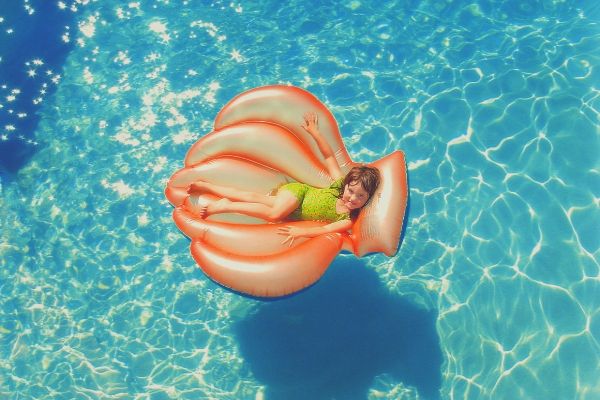Back floating is one of the best indicators of your child’s overall comfort in the water. In previous lessons, we dove into helping your child achieve forward propulsion in the water, in this lesson we’ll work back to establishing further comfort. Back floating is one of the more interesting swimming skills because for beginners it can provoke intense fear, while for those who master it, back floating offers soothing feelings of comfort and relaxation.
Learning to back float is about more than just being able to feel relaxed and calm in the water. It is also a vital safer swimming skill. A child who can back float is able to take a break from swimming and find air anywhere in the pool. Mastering the back float will increase the distance your child can travel in the pool and the duration he or she can swim, while minimizing dangerous fatigue.
Teaching a child the FUNdamentals of floating on their back requires patience and calm instruction. It usually takes some time, too! However, even if your child rejects it at first, every child can master the back float with positive reinforcement, loving support and repetitive practice.
Help children recognize their own buoyancy.
There’s a wide range of reactions that children just beginning to learn the back float might display. Some kids open up to back float quickly and with ease, while others struggle at first and experience varying levels of fear. Each child is completely different and even kids who seem comfortable swimming on their front may reactive completely opposite when placed on their backs.
At first, many children don’t expect to float and instead focus on the idea that they may sink. This can cause them to tense their muscles or sit up in the water, which can become a self-fulfilling prophecy because tense muscles sink and a relaxed horizontal body position is critical to floating. However, kids have natural buoyancy that can be harnessed with practice. Each person floats a little bit differently than everyone else, but with comfort and relaxation, everyone can float.
Once young children realize that they can float, many of them find back floating activities to be relaxing and fun. Although some kids are definitely nervous as they learn to float on their backs, we have seen countless children learn to float through the love and support of their parents, caregivers, and swim instructors.
Your first goal should be to help your child believe that yes, they can float! And you are going to help them learn how.
If your child appears comfortable or not, start teaching back float with full hands-on support
We start every beginner back-floater out the same way - getting used to water in the ears and building up comfort on the back
- Start with their head laid back on your shoulder, facing up - cheek to cheek
- Dip down until your shoulder is at water level and your child has their ears in the water
- Your knees are bent, but you’re standing up in the water - your child is laying out horizontal across the water
- Gently support your child’s back with one hand and their cheek with the other
- Stay stationary and speak words of encouragement to your child
- Stay here for 5-10 seconds and practice this skill 2-5 times - as long as your child is cheerful and happy to do so
Once your child seems comfortable (this may take several lessons together), you can change the support you provide.
- Moving from the cheek to cheek hold we outlined above, gently support the back of your child’s head
- Stand up and make eye contact with your child
- Pull his or her head into your belly area for added feelings of support
- 1 hand should be supporting the head and the other should be gently supporting the upper back
- Help your child getting their body into an “x” position with arms and legs out at the sides
Once your child is comfortable with this hold you can move your support once again
- Change your hand placement again from the back of the head to gently supporting your child’s arms
- Your child should have arms and legs out to their sides, forming an “x” with their body
If you child can handle this comfortably, you can try letting go! Keep eye contact, it helps children stay confident and supported the first couple times they attempt floating without your support. For every float attempt, the goal is to float for around 10 seconds (of more if your likes!) and you can practice back floating 2-5 times any lesson.
Distraction Tactics: Talk about something other than floating!
While your child begins to float, talk about fun things like favorite ice cream flavors, coolest superheroes, and funniest animals. This distraction allows your child to think about anything other than floating. Sometimes, not thinking about it is the thing that needs to happen in order for a kid to get the hang of this!
At our swim school, we ask children to name their favorite food, game, toy or superhero and then we count that outloud, 1-pizza, 2-pizza, 3-pizza…
How do you know if a child is floating well?
Your child’s arms and legs should be relaxed and loose in the X-formation. If you see tense legs and arms, that may indicate fear. When a child is fearful of floating, do not force it. Slow down, or stop and try again another day.
Your child’s head should be resting gently in the water, with the water at ear level. If your child resists getting water in their ears, you can try some earplugs and an earband. This can help your child feel more comfortable in the pool without being worried about getting water in their ears.
What comes after learning to back float?
We have 4 more lessons to go in this series, including how to make sure your child knows basic swimming safety and water survival skills. Don’t forget to sign up for this series to show up right in your email inbox, so that you do not miss a single lesson! We will send you the remaining 4 lessons as soon as each one is posted.
We also invite you to come check out our facilities here at the Swim Revolution! We offer lessons for kids of all ages, and our FUNdamentals series is especially popular! Designed for children ages 2.5 through 8 years old, it provides you with the support you need to accomplish each of these swimming instruction goals with your kids.





